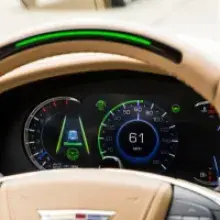SHERIDAN, WYOMING – October 12, 2024 – For 100 years, General Motors has been testing new cars and technology on a vast compound in suburban Michigan known as the Milford Proving Ground. Sitting neatly between GM's main hubs in Flint, Detroit, Lansing, and Pontiac, Milford is the oldest dedicated vehicle testing facility in the world.
Sept. 25 marked 100 years since Milford opened its doors. The site continues to play a critical role in testing and development of all GM cars, trucks, and SUVs. Milford is extraordinary in many ways - in its size, scope, and history. Here are 20 things to know about this historic site:
Size, Scale, Speed
- GM purchased the original Milford land in 1923 for just over $100,000. The site originally was nicknamed "The Bluffs" for its rugged terrain and 267 feet of elevation change - a rare height for generally pancake-flat southeast Michigan.
- Originally 1,125 acres, two buildings and 5.5 miles of test roads, the proving ground now covers 4,000+ acres and features more than 150 buildings. Milford has nearly 150 miles of two-lane roads, including 131 miles of pavement and 16 miles of gravel. If it were one continuous highway, drivers could travel at 70 mph for two hours, turn around, and drive two hours back again.
- GM staff drive more than 15 million development and testing miles per year in vehicles at Milford.
- Engineers at Milford can simulate extreme environmental conditions, including temperatures ranging from -40 degrees Fahrenheit to 130 degrees Fahrenheit, altitudes from -700 feet to 12,500 feet, humidity from 10% to 90%, and wind speeds from 0 to 100 mph.
- The crash lab includes 140,000 pounds (70 tons) of reinforced concrete tied into bedrock that sits below the proving ground for stability.
- "Black Lake" is a 67-acre test pad (equivalent to 51 football fields) used for dynamic vehicle testing in different weather conditions.
- The 2.9-mile-long Milford Road Course emulates sections of famous racetracks around the world. The track consists of 17 turns, each designed to test specific performance requirements. The straightaway allows for speeds above 150 mph.
- The proving ground has 115 acres of parking lots for its more than 4,200 employees, with 175 acres of lawn.
- Milford has its own electrical substation, wastewater treatment facility, on-site Fire and EMS staff as well as an on-site medical facility, operating 24 hours a day, 365 days a year.
A Century of Innovation
Here are a few noteworthy automotive innovations that were invented at GM - and brought to life at Milford:
- The first vehicle rollover tests were conducted at Milford in 1934. Today, our indoor rollover facility is capable of rolling a vehicle on its side, roof, or end-over-end.
- Guardrails were first developed at Milford to keep out-of-control vehicles from veering into oncoming traffic. Today, Milford has more than 130 miles of guardrails.
- In the 1930s, GM engineers developed the first mass-produced automatic transmission, the Hydra-Matic and subjected it to extensive on-road testing at Milford.
- GM demonstrated one of the first autonomous car concepts in an exhibit called "Futurama" at the 1939 World's Fair. By the 1950s, GM was testing a self-driving Chevy that followed a cable embedded in Milford's circular test track. GM and Cruise began testing the first fully autonomous Chevy Bolt in 2016.
- In 1953 GM launched the first Chevrolet Corvette. Every Corvette since has been tested at Milford, including the 1,064-horsepower 2025 Corvette ZR1.
- The "infant love seat" was developed at Milford and introduced in 1969. It became a model for future child car seats.
- GM reduced driving emissions with the invention of the catalytic converter, which reduces toxic gas emissions from internal combustion engines. By 1975, all GM U.S. and Canadian gas vehicles had a catalytic converter.
- Originally developed by the Air Force for testing ejection seats, GM has completed thousands of crash tests at Milford using crash test dummies. Standing 5 feet, 9 inches tall, and weighing 173 pounds, the Hybrid III model became the widest-used crash test dummy model in the world.
- GM engineers had another industry-changing safety idea, a vehicle system that helps alert drivers to check the back seat before exiting the vehicle. After testing at Milford, GM first rolled out the Rear Seat Reminder feature on the 2017 GMC Acadia.
- GM developed Super Cruise*, the world's first hands-free driver assistance technology for use on compatible roads. Tested at MPG and launched on the 2018 Cadillac CT6, it uses data from vehicle cameras, sensors and LiDAR, along with a driver attention monitoring system. In 2024, GM announced it would be expanding the Super Cruise network to ~750,000 miles of roads in the U.S. and Canada by the end of 2025.
Always pay attention while driving and when using Super Cruise. Do not use a hand-held device. Requires active Super Cruise plan or trial. Terms apply. Visit cadillacsupercruise.com chevysupercruise.com, or gmc.com/connectivity-technology/super-cruise for compatible roads and full details.
